Hawks in New Mexico embody the wild spirit of this landscape, offering an exciting and educational exploration for anyone keen to delve into the world of these fascinating birds. They grace the Southwestern skies, providing bird watchers and nature enthusiasts with a captivating display of avian power and grace.
In the vast landscapes of New Mexico, stretching from the arid desert plains to the lofty mountain ranges, a variety of magnificent birds of prey find their sanctuary. Among these, hawks offer an enthralling sight with their majestic flight and keen hunting skills.
Types of Hawk in New Mexico
Red-tailed Hawks: Frequent sight in open areas throughout the state, particularly in the arid lands near White Sands National Park.
Cooper’s Hawks: Often seen in forests and suburban areas, they are prevalent around Santa Fe National Forest.
Swainson’s Hawks: Known for their preference for open plains, they can frequently be spotted in the grasslands surrounding the city of Roswell.
Northern Harrier: Regularly sighted in marshlands and grasslands such as the Bitter Lake National Wildlife Refuge.
Ferruginous Hawks: Preferring open plains, these hawks can be seen around areas like Clayton Lake State Park.
Sharp-shinned Hawks: These hawks prefer dense forests and can be spotted in the Gila National Forest.
Zone-tailed Hawks: A common sight in wooded areas, particularly along the Gila River.
Harris’s Hawks: Found in the desert areas of Southern New Mexico, particularly around the Organ Mountains-Desert Peaks National Monument.
Northern Goshawk: While not as common, they can be occasionally spotted in forested areas such as Carson National Forest.
Rough-legged Hawks: Mostly a winter visitor to New Mexico, these hawks can be seen in the open areas near Taos.
Broad-winged Hawks: Sightings are typically during migration seasons, especially in the northern mountains around the city of Los Alamos.
Gray Hawk: Found in the southern part of the state, these hawks can be seen near the Animas River Valley.
Common Black Hawks: A rare sight, but some can be seen in the Gila Wilderness area, especially near rivers and streams.
Osprey: These fish-eating birds can be seen in locations with ample fishing opportunities, such as the Navajo Lake State Park.
New Mexico Hawks Photo Guide
Red-tailed Hawk (Buteo jamaicensis)

The Red-tailed Hawk is a large bird of prey that is commonly found across North America. This species is part of the genus Buteo, which is often referred to as the “true hawks,” and includes more than two dozen species of raptors.
Red-tailed Hawks have a robust size, ranging from 18 to 26 inches in length and sporting a wingspan that can exceed 4 feet. They have a broad, rounded set of wings and a short, wide red tail. This species is most easily recognized by its rich, rust-colored tail, which gives it its common name. However, juvenile hawks might not yet have this distinctive feature.
Their feathers are generally dark brown on their dorsal side (back) with a lighter, often speckled, ventral side (front). The intensity and pattern of their plumage can vary significantly based on their age and geographic location, as there are about 14 recognized subspecies of Red-tailed Hawks.
As for their diet, Red-tailed Hawks are carnivores and have a broad diet that includes rodents, ground rabbits, reptiles, and other birds. They are skilled hunters that typically sit on high perches and use their keen eyesight to spot potential prey. Once they have identified a target, they swoop down to capture it with their powerful talons.
Red-tailed Hawks mate for life and build nests high off the ground, often in tall trees or on cliff edges. Their nests are made of sticks and can be quite large. They typically lay 1-3 eggs per year, which are incubated by both parents.
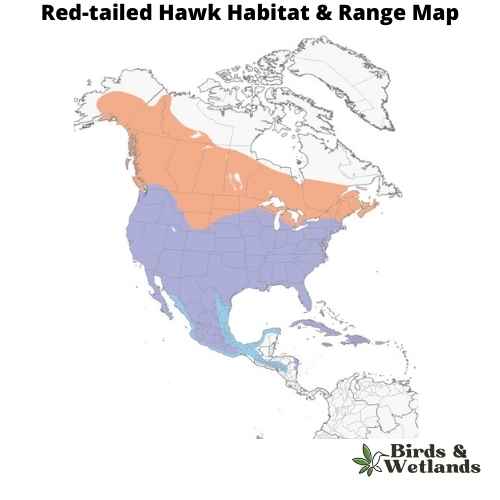
Red-tailed Hawk Sound
Cooper’s Hawk (Accipiter cooperii)

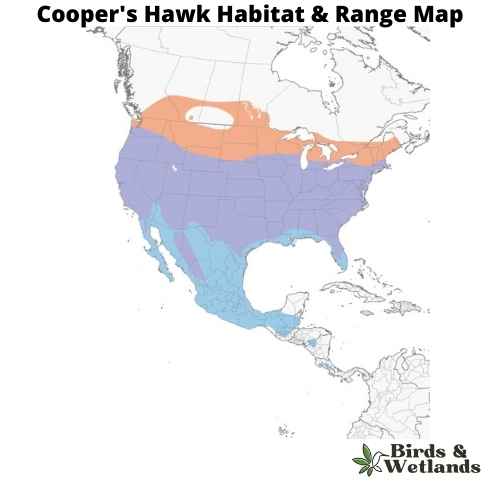
Listen:
The Cooper’s Hawk is a medium-sized bird of prey native to North America. Known for its agility and speed, it is part of the Accipitridae hawk species, which also includes other hawks, eagles, and kites.
Cooper’s Hawks are typically about 14 to 20 inches in length, with a wingspan ranging from 27 to 36 inches. They are known for their distinctive long, rounded tails and short, rounded wings. They have a steely blue gray top, with rusty bars on their underparts and thick, dark bands on their tails.
The Cooper’s Hawk is a skilled predator, primarily hunting birds and small mammals. They are adept at hunting in both dense forests and open areas, often catching prey mid-air in high-speed pursuits. They have also been known to visit the backyard bird feeder, not for the seed, but to prey on the smaller birds that gather there.
Cooper’s Hawks often build nests in dense tree canopies where they are well concealed. The female usually lays 3 to 5 eggs, and both parents share incubation duties. The young hawks fledge after about a month but will stay close to the nest, relying on their parents for food as they learn to hunt.
Swainson’s Hawk (Buteo swainsoni)
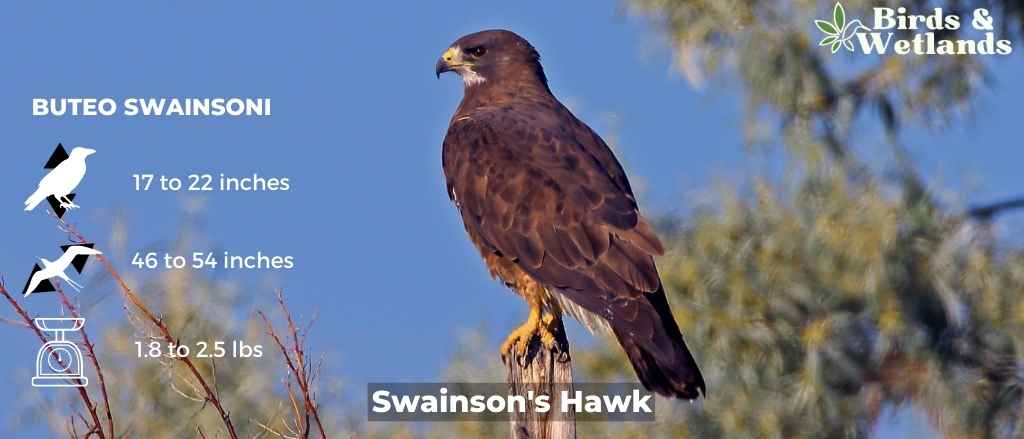
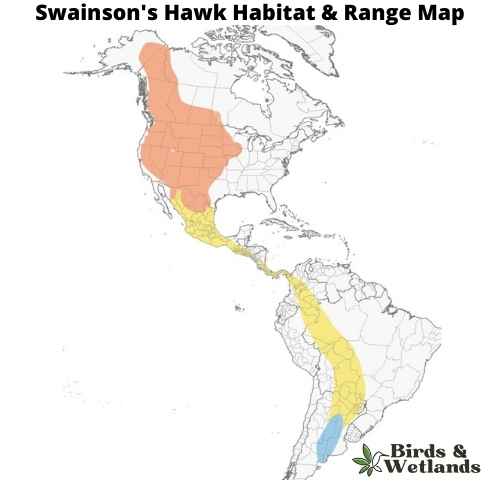
Listen: Swainson’s Hawk
Swainson’s Hawk is a medium-sized hawk that is found in North America and South America, Scientific Name: Buteo swainsoni.
The bird has a blue-gray plumage with a dark brown back, wings, and tail. It also has a white chest and belly. The beak and feet are black, but the eyes are yellow. They are often confused with Cooper’s Hawk because of similar coloring, but Swainson’s Hawks have wider tails and longer wings than their cousin species.
These birds eat small rodents such as gophers and mice. They also eat insects like grasshoppers and crickets during the summer months when they’re plentiful. They sometimes steal prey from other birds of prey such as Northern Harriers who hunt the same prey.
Swainson’s Hawks build nests on rocky cliffs near water sources where they can find food easily. They lay three to five eggs that hatch after about two months into fluffy brown baby hawks who leave the nest after about three weeks (or when they’re big enough).
Northern Harrier (Circus hudsonius)

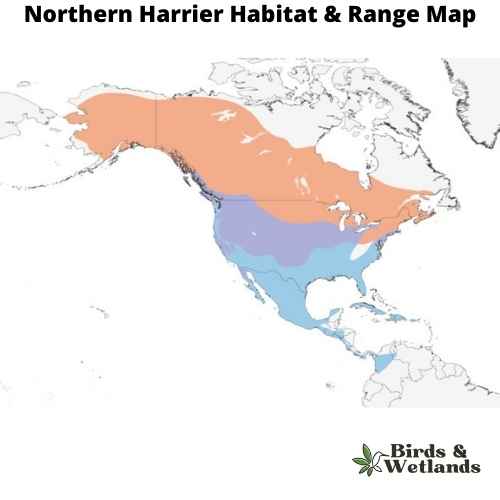
Listen:
The Northern Harrier is a medium-sized, slender hawk.
Adult birds are gray above, with pale bars on the wing feathers and white markings on the underwings and a white rump patch. The breast is barred with black and white, and the belly is streaked with brown.
They prefer open areas, such as grasslands and marshes, but can be found in almost any open habitat except dense woods.
Northern Harriers are opportunistic hunters that feed on small mammals such as mice, voles and rabbits as well as birds including quail, grouse and ducks. They hunt by flying low over open spaces such as fields or marshes.
Northern harrier nests on the ground in lowlands or hillsides near water bodies. It lays two to four eggs which hatch after 24 days of incubation by both parents. The chicks fledge after 30 days of hatching and remain dependent on their parents for another three weeks during which they learn how to fly.
Ferruginous Hawk (Buteo regalis)

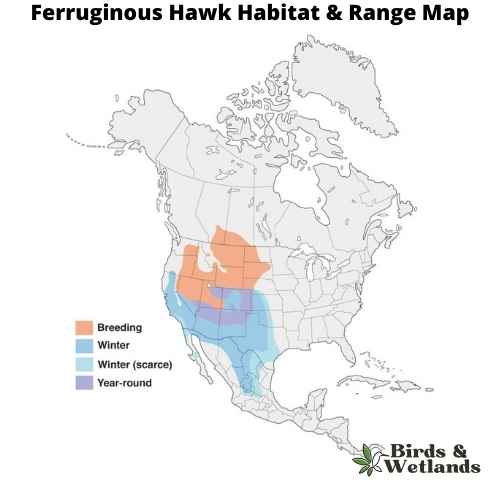
Ferruginous Hawk Sound
Scientific Name: Buteo regalis
Length: 20 to 27 in
Wingspan: 48 to 60 in
Weight: 32.0 to 80.0 oz
The Ferruginous Hawkis the largest hawk species native to North America. Known for its distinctive coloration and impressive size, this bird of prey predominantly inhabits the open landscapes of the western United States and parts of Canada.
Ferruginous Hawks are notable for their “ferruginous” or rust-colored back and shoulders, which contrasts sharply with the bird’s white underside. The hawk also has broad, rounded wings and a large, gape-mouthed beak. Ferruginous hawks exhibit dark morph and light morphs. Dark morphs have dark brown plumage, while light morphs display lighter, reddish-brown plumage. Morphs vary geographically.
Primarily feeding on small to medium sized mammals like rabbits and prairie dogs, the Ferruginous Hawk is an agile hunter, often seen soaring high above the ground or perched prominently while scanning for prey. It occasionally feeds on birds, reptiles, and insects as well.
Nesting for Ferruginous Hawks typically occurs on cliffs, hillsides, or large trees. The female lays between 2 to 5 eggs, and both parents share in the incubation and rearing of the chicks. The Ferruginous Hawk is a relatively solitary bird outside of the breeding season, and its call is a loud, high-pitched scream, often heard during courtship or near the nest.
Sharp-shinned Hawk (Accipiter striatus)

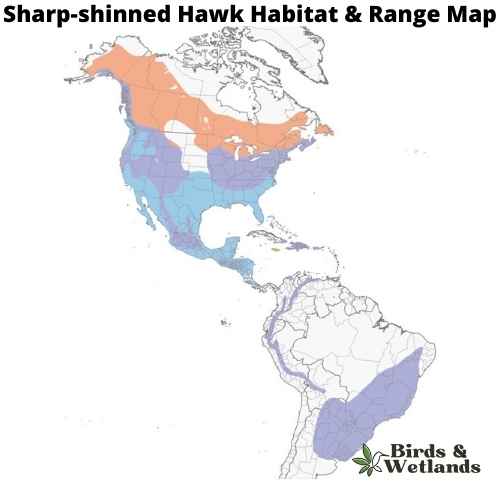
Listen:
The adult bird is brown on top and white underneath, with a dark brown band across its chest. It has short, rounded wings and a long tail that makes it look larger than it actually is. Adult sharp shinned hawks have black eyes, which are surrounded by white feathers. The female Sharp-shinned Hawk is browner than the male, who has darker brown markings on his back.
Sharp-shinned Hawks prefer open country for their habitat, including fields and meadows where they can hunt for mice and other small animals. They can be found throughout the United States but are most common in the east.
Sharp-shinned Hawks eat mostly small birds, such as sparrows and warblers, as well as small mammals such as mice and gophers. They catch prey by surprise using their incredible speed and agility, diving out of the sky at speeds up to 200 mph.
Sharp-shinned Hawks have an unusual hunting style for hawks—they prefer to catch their prey from perches above trees or telephone wires, rather than swooping down from above like most other hawks do and can often be seen hunting near bird feeders.
Zone-tailed Hawk (Buteo albonotatus)
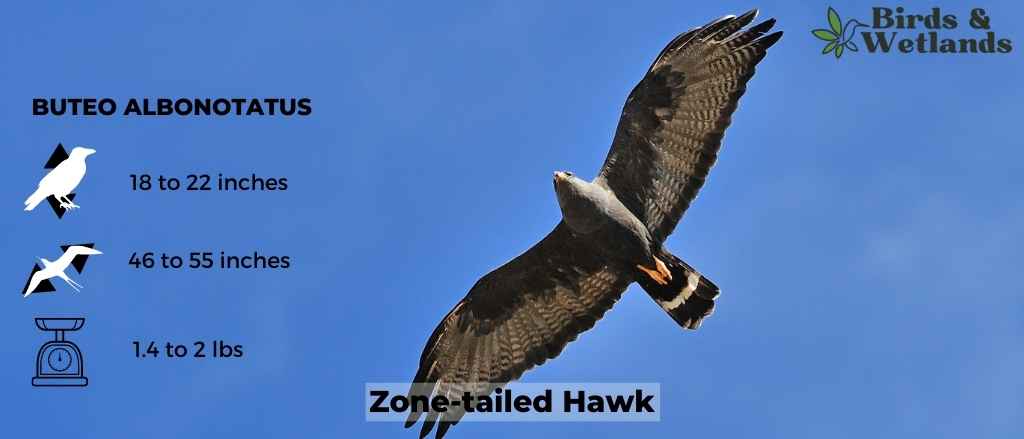

Zone-tailed Hawk Sound
Scientific Name: Buteo albonotatus
Length: 18 to 22 in
Wingspan: 46 to 55 in
Weight: 1.2 to 2 lb
The Zone-tailed Hawk, or Buteo albonotatus, is a medium-sized bird of prey known for its unique appearance and behavior that mimics turkey vultures, a strategy used to deceive prey. This raptor is primarily found in the warmer regions of the Americas, including the southwestern United States, Mexico, and down to Argentina.
The Zone-tailed Hawks body are predominantly black, with white bands, or “zones,” on the tail, which give the bird its name. From a distance, the Zone-tailed Hawk can easily be mistaken for a turkey vulture due to its similar coloration and flight pattern.
Zone-tailed Hawk feeds on small mammals, birds, and reptiles. Its hunting strategy is particularly clever. By mimicking the less-threatening turkey vulture in flight, it can often approach prey unnoticed before launching a surprise attack.
Nesting typically takes place in trees, cliffs, or even on man-made structures. The female lays 1 to 3 eggs, and both parents share incubation and feeding duties.
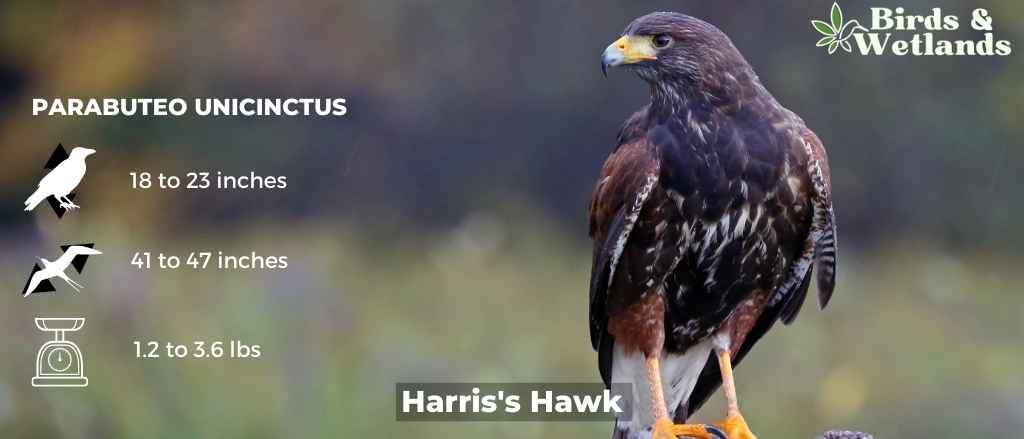
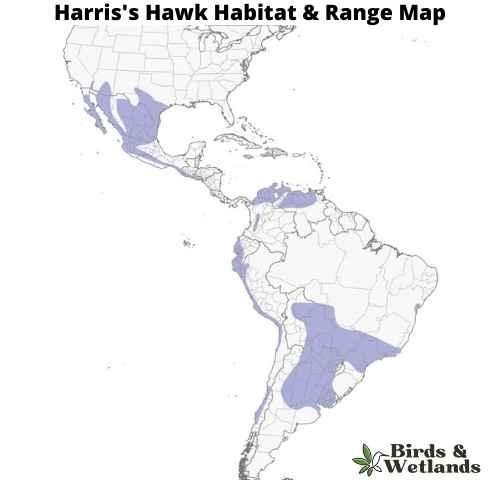
Harris’s Hawk Sound
Scientific Name: Parabuteo unicinctus
Length: 18 to 23 in
Wingspan: 41 to 47 in
Weight: 1.2 to 3.6 lb
The Harris’s Hawk is a unique bird of prey, recognized by its distinct social behavior and richly colored plumage. This raptor prefers semi-arid habitats like desert scrub, woodlands, and savannas.
Harris’s Hawk sports a dark brown or chestnut-brown body, with striking reddish-brown shoulders and legs. A characteristic feature of this bird is its white-tipped tail, along with a white band on the underside of its tail feathers.
Harris’s Hawks diet mainly consists of small mammals, birds, and lizards. One of the unique behavioral traits of this species is that it often hunts cooperatively in groups, a rarity among raptors. This group hunting strategy often involves surrounding and flushing out prey, or taking turns chasing it, which increases the likelihood of a successful hunt. Harris’s Hawk also engage in “stacking,” where they perch on top of each other, which is a behavior rarely seen in birds of prey.
Nesting for Harris’s Hawks involves the building of a platform of sticks in a tree or cactus, where the female usually lays 2 to 4 eggs. Both parents share in the incubation and rearing of the chicks, with sometimes even older offspring assisting in the process.
Northern Goshawk (Accipiter gentilis)


Listen:
The Northern Goshawk is a medium-sized hawk that is found in North America, Europe and Asia. It has brown eyes, a large sharp beak, and dark brown plumage on its upperparts and head, with white underparts that are spotted with brown barring. Its tail feathers are grayish-black with a dark band near the tip.
Northern goshawks eat squirrels, rabbits, grouse, woodchucks and other small mammals like voles or mice (which they often eat whole). They will also take larger prey such as deer fawns or even adult deer if they have no other choice. They have broad wings with long feathers that allow them to glide through the air when they catch their prey. They also have an excellent sense of smell which helps them locate their food source.
The Northern Goshawk builds its nest in a tree cavity or on a ledge, usually on the edge of an open area so it can easily see prey below. The female lays 3 to 5 eggs over two days and incubates them for 28 to 30 days while the male brings food to her every few hours until they hatch. The young fledge after about 6 weeks and leave the nest when they are about 10 weeks old.
Rough-legged Hawk (Buteo lagopus)

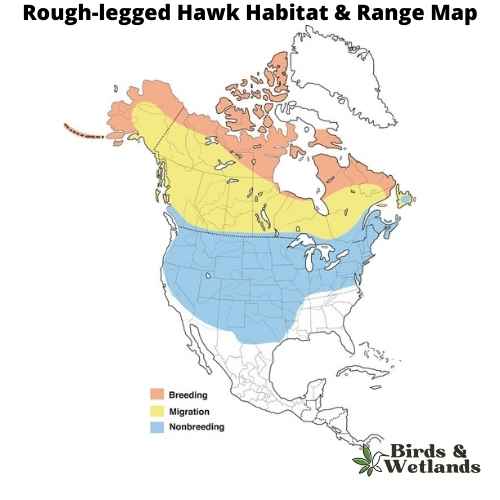
Rough-legged Hawk Sound
The Rough-legged Hawk is a large, raptor that is native to North America. It is also known as the American Rough-legged Hawk. Scientific Name: Buteo lagopus
The Rough-legged Hawk is a medium-sized hawk with a distinctive appearance, with dark brown feathers on its back and light brown feathers on its underside and broad thin wings. The hawk’s legs are also covered in dark feathers, which help to distinguish it from other species of hawk. The tail is barred with black and white. They have yellow eyes and dark feet.
Rough-legged Hawks hunt from above ground level, swooping down to catch its prey in its talons. When hunting for food, they prefer to eat small mammals such as squirrels and rabbits but will also eat birds if there aren’t any small mammals available. Although they eat a variety of small animals including birds, rodents, bats and reptiles, they rely heavily on fish for food during breeding season because it provides them with protein and calcium needed to produce eggs.
Broad-winged Hawk (Buteo platypterus)

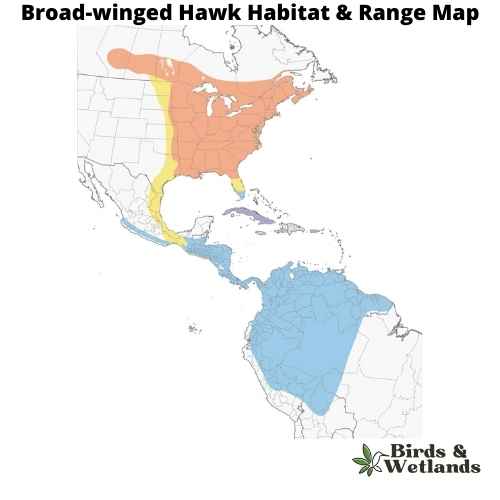
Broad-winged Hawk Sound
The Broad-winged Hawk holds a commanding presence as one of the largest hawks in the world, known for its broad wings. Its formidable size is a testament to its prowess as a bird of prey, effortlessly navigating the open skies in search of food.
Their distinctive appearance sets them apart. The adults exhibit a striking black and white pattern, complemented by a rusty breast and buff underparts and brown wings. In contrast, juveniles are adorned with a brown plumage, marked by pale edges on their feathers, adding to their distinctive youthful charm.
These hawks are most commonly found in open areas, such as farmlands or grasslands interspersed with scattered trees, which provide optimal conditions for when hawks hunt.
When it comes to their diet, Broad-winged Hawks feed on small rodents like mice, rats, squirrels, rabbits, and voles. Broad winged hawks breed during the spring and summer months then migrate to central and south America.
Gray Hawk (Buteo plagiatus)

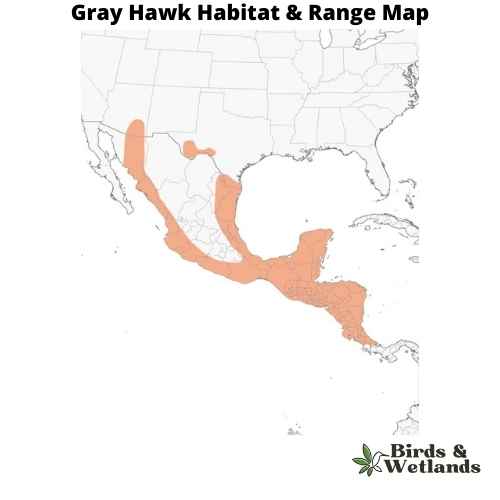
Gray Hawk Sound
Scientific Name: Buteo plagiatus
Length: 18–24 in
Wingspan: 82-98 cm
Weight: 16.8 oz
The Gray Hawk is a small bird of prey native to the Americas. Known for its distinct coloration and elegant flight, this raptor is found in both the southwestern United States and across Central and South America.
Gray Hawks plumage is characterized by a light gray body, contrasted with a darker gray back and wings. Its tail features broad white and gray bands, making it a distinctive feature.
Primarily hunting from a perch, the Gray Hawk feeds mainly on small mammals, birds, and reptiles, including lizards and snakes. It often patrols the edges of clearings, diving swiftly to catch prey off guard.
Nesting for the Gray Hawk typically occurs in trees. The female usually lays 1 to 3 eggs, and both parents share in incubation duties. The nestlings are generally dependent on the parents for food for a few weeks after hatching.
The Gray Hawk’s call is a high-pitched, plaintive scream, which is often repeated several times. The species is primarily a solitary bird, usually seen alone or in pairs.
Common Black Hawk (Buteogallus anthracinus)
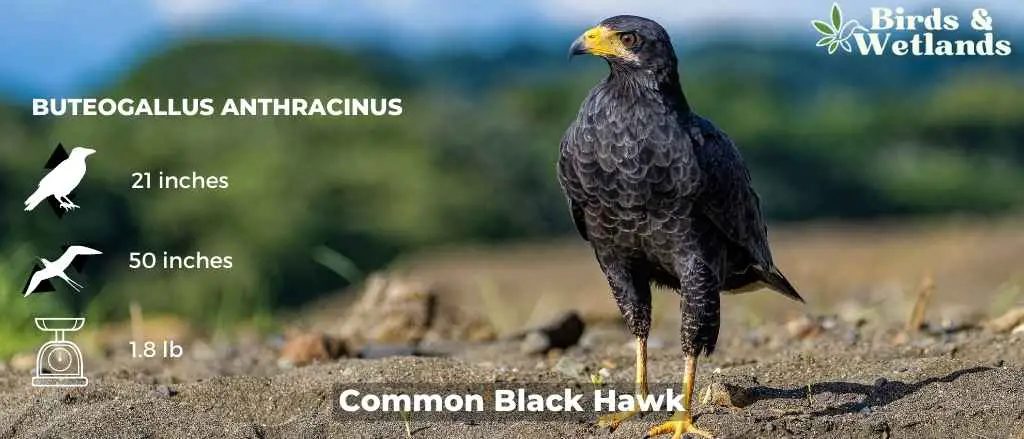
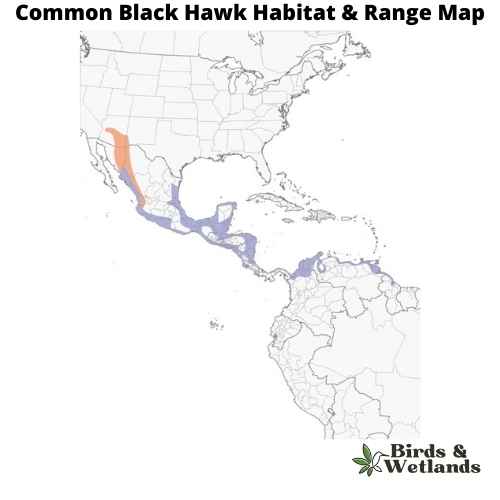
Common Black Hawk Sound
Scientific Name: Buteogallus anthracinus
Length: 21 in
Wingspan: 50 in
Weight: 840g
The black hawk has dark brown feathers on its back and chest, with white feathers on its belly and under its tail. The back feathers have white spots and bars that give it an overall speckled appearance. Its eyes are yellowish-brown, and its legs are long and pinkish-white in color with black talons at the end.
Common Black Hawks tend to live in open spaces near water sources like lakes or rivers because they need water for bathing and drinking as well as hunting prey animals that may be found near such areas.
Common Black Hawks prefer to hunt for small mammals like rabbits, squirrels, and rats. They also eat reptiles like snakes and lizards if they can find them.
Osprey (Pandion haliaetus)

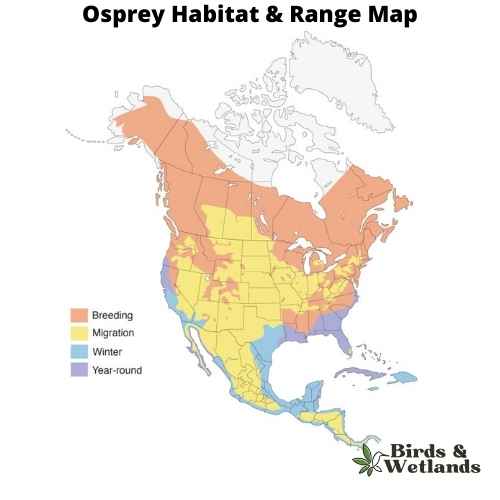
Osprey Sound
Scientific Name: Pandion haliaetus
Length: 50–66 cm (19+1⁄2–26 in)
Wingspan: 127–180 cm (50–71 in)
Weight: 0.9–2.1 kg (2 lb 0 oz – 4 lb 10 oz)
The Osprey, a fascinating bird of prey, is universally known for its exceptional hunting prowess and striking physical characteristics. Osprey are dark brown hawks on the upperparts, contrasting beautifully with the predominantly white underparts, and a distinctive dark band that stretches across the eyes towards the sides of its head.
Equipped with specialized talons and a reversible outer toe, the Osprey’s hunting strategy involves a spectacular plunge-dive into bodies of water, often emerging with a fish securely gripped in its claws.
Found on every continent except Antarctica, the Osprey is a cosmopolitan species favoring habitats near water bodies such as lakes, rivers, and coastal areas, reflecting its piscivorous diet. This bird has a diet almost exclusively of fish, making it a unique member of the raptor family and often referred to as the sea hawk or fish hawk. They locate their prey from the air, often hovering before plunging feet-first to capture a fish. When it comes to breeding, Ospreys are monogamous, often mating for life.
They construct large, bulky nests made of sticks, lined with softer materials, and prefer elevated or isolated areas such as treetops or artificial structures like utility poles. Both parents share the responsibility of incubating the eggs and rearing the chicks.
Where to Spot Hawks in New Mexico
Gila National Forest: This extensive wilderness area is home to the Red-tailed Hawk, Cooper’s Hawk, and Northern Goshawk, especially in the riparian areas and mixed conifer forests.
Bosque del Apache National Wildlife Refuge: The refuge is well-known for attracting a range of raptors including Northern Harriers and Sharp-shinned Hawks, particularly during the winter.
HawkWatch International’s Manzano Mountains site: This site is a prime spot for viewing raptor migration in the spring, with Broad-winged Hawks and Ferruginous Hawks among the visitors.
Santa Fe National Forest: The forest’s extensive wilderness provides a habitat for Red-tailed Hawk, Northern Goshawk, and Cooper’s Hawk and other north American hawks that feast on ground squirrels.
| Neighbouring State’s Hawks | Hawk Watching Site |
|---|---|
| Hawk Species in Arizona | Arizona-Sonora Desert Museum |
| Hawk Species in Utah | HawkWatch International’s Salt Lake City site |
| Hawk Species in Colorado | Rocky Mountain Hawk Watch |
| Hawk Species in Oklahoma | Black Mesa Nature Preserve |
| Hawk Species in Texas | Smith Point Hawk Watch |

